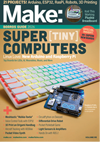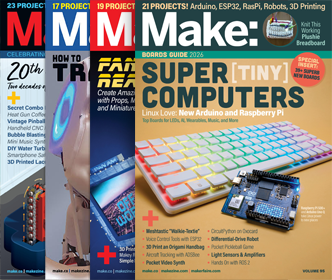
The Cortado from Punch Through Design is a new Arduino compatible board with built-in Bluetooth LE support.
Punch Through is better known for its iPhone accessories targeted at consumers—and software libraries for iOS developers—than development boards targeted at makers, although you might well have come across their Light Blue app on iOS and OS X if you’ve done any development using Bluetooth LE.
An Arduino compatible board with built-in Bluetooth LE also isn’t a new idea. The RFduino had a huge Kickstarter and is now in its final week of shipping boards to backers before opening to general sales, the BLEduino—again after a successful Kickstarter—is now almost ready to ship.
So what does the Cortado board do differently?

Well, there aren’t any wires to be seen, loading sketches onto the board is done over Bluetooth LE, and that can be done not just from the traditional Arduino development environment but also from your iPad or Android tablet—and also via Bluetooth LE.
Which might well be the start of an interesting trend—with so many people moving to tablets as their day-to-day computing platform, it’d be unsurprising to see developers also moving off laptop and desktop platforms.

The board has 8 digital I/O pins with 2 optional analog inputs, an RGB LED, and a 3 axis accelerometer on-board. It will even ship with the battery in place and, so long as you download their app to your phone ahead of time, you’ll even get a push notification when it arrives at your door.
Introducing the Cortado.
Like the Spark Core the board is very much designed from the ground up to be used as part of the Internet of Things. But unlike the Spark Core—which is based around Wi-Fi and therefore has much higher power requirements—it should run for over a year from the on-board coin cell. This board is intended for embedding deep within projects, and then forgetting about.
I spoke with Colin Karpfinger—the founder of Punch Through Design—ahead of their launch today about the Cortado,
How is the Cortado different from other BLE enabled Arduino compatible boards, like the RFduino and the BLEduino?
We set out to not just make an Arduino-with-BLE, but rather change the way you interact. So for one, you program the Cortado via BLE, instead of plugging it in (like RFduino / BLEduino). We have some neat ways of showing this. You’ll be able to program the Cortado you receive in the mail without even opening the box, which I think is proof that the interaction has changed.
Remote programming via BLE seems to be one of the key features, how does that work under the hood?
The Arduino code is compiled on whatever platform you’re using and then [transferred to the board] via a custom BLE profile we’ve implemented. We use the write-without-response characteristic to get as much speed as possible, and do some error checking to avoid issues.
Programming from a desktop machine is done in the existing Arduino IDE via a proxy? How does that work?
The Arduino IDE has the ability to call custom ‘loader’ apps. It passes the file path of the compiled hex. So you will run our loader app, which handles all the connecting via BLE, and then just use the Arduino IDE as you would normally.
Programming on iOS (and Android) is done in a native application. Did you port the Arduino IDE to the mobile platforms? Or did you reimplement from scratch?
We implemented a custom app that has some simple text-editing abilities. The goal is push something that is usable right away and then keep improving it and adding nice-to-have features as we go on.
The Arduino IDE is open source, are you going to make your iOS (and Android) IDE code open source?
We are looking at releasing two apps, one to handle programming and one meant for debugging / interacting. The latter will be built into our existing app LightBlue. We will open source the programming IDEs, and would love to find helpful contributors.
Are you anticipating allowing people to add support for other boards, in the same way Arduino does?
Right now we’re focused on making the experienced the best with the Cortado. We will publish our BLE-Programming profile, and other hardware developers could implement that.
The board is based around an M328P, could you talk about that choice?
We wanted to pick something small and ubiquitous. Everyone knows the 328P…
The BLE module your using is Punch Through’s own design, is that right? Can you tell us more about it?
Correct! It’s a small general purpose BLE module that we’ve had great success with so far. It will be in several products that you’ll find in 2014.
Why did you decide to roll your own Bluetooth SoC, why not use one of the existing modules?
We have worked on a ton of BLE products, and we found certain other modules lacking—either in ability, support, or price. We had some longer-term goals with hardware, such as the Cortado, that we wanted to support as best we could. It became clear that building our own module was the best way to do that. It wasn’t a quick process, but it is really great now that we’re done.
This is Punch Through’s first developer board, you’re mainly know for iPhone accessories. Why a board aimed at makers?
Makers are innovators. We want to support the people building tomorrow’s products, whether that is someone in his garage, or a new branch of a big company. This is our way of doing that. The Module is our way of helping them once they’re ready for production.
Bluetooth has always had a bad reputation amongst programmers. But the introduction of Bluetooth LE has changed all that. How do you see the space developing?
I see BLE being the protocol driving forward the IoT and connected devices. There have been a few major driving forces, but the fact that you have a protocol made for low power sensors in all the leading smart phones is huge.
Would you anticipate building other hardware aimed at the maker community?
Certainly. We think the Cortado is pretty revolutionary, however, so we have our hands full!
The Cortado board is available for pre-order for $18 (plus shipping) from today from Punch Through Design.
ADVERTISEMENT









